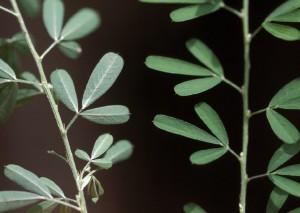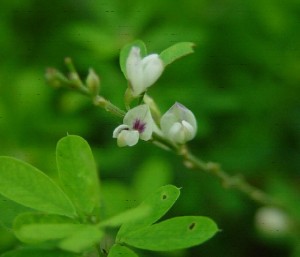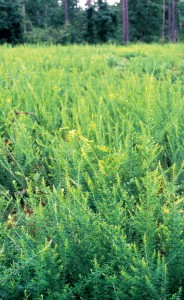Chinese Bush Clover
Lespedeza cuneata sericea lespedeza
Chinese lespedeza, Chinese bush clover, silky bush clover, hairy lespedeza/bush cloverLonicera japonica
Native Origin: Native to Asia, silky bush clover was introduced in the 1940s as a forage and hay crop for livestock, particularly on poor, eroded soils. Another introduction done for good purposes, this species didn’t live up to expectations for it contains high levels of tanins, making it unpalatable to livestock, and doesn’t work well as an erosion control agent. It should not be confused with our native lespedezas (bush clovers) that occur naturally in prairies, glades and open woodlands.
Description, Habitat & Ecological Effect: This member of the Pea family, is a perennial herbaceous plant that grows 3 to 5 feet tall. Compound alternate leaves have three leaflets, each one-half to one inch long, that are narrow and pointed at the end. Somewhat woody leaves and stems both carry small flattened hairs and have a silver gray-green color. Small cream-white flowers bloom from late July into October. Each flower produces one small shiny, flattened oval seed that may range in color from tan through purple brown. Reproduction is almost entirely by seed. Seeds are disbursed to new areas by animals. Seeds can remain viable for up to 20 years, and, in some conditions, for far longer. The thick seed coat needs some form of scarification before germination can occur; this can be done by the acid encountered in an animal’s digestive tract , by any force that rubs, rasps and removes the husk, or by a slower process of simple repeat weathering. Chinese bush clover is tolerant of a wide variety of soil types, and will grow on eroded and sterile soils; the plants grow woody taproots, up to 4 feet deep, that enable a high degree of drought tolerance. It will tolerate and reproduce in light shade. It grows well in open areas and has invaded and replaced native vegetation in open woodlands, savannahs, prairies, glades, fence rows, borders of wetlands and ponds, and roadsides (where even further spread occurs by mowing equipment spreading seed). Once established, it out competes native plants for soil nutrients and moisture and even sunlight. Long seed viability guarantees years of continued new growth.
Manual: Only the newest, youngest, least-well established plants can be hand-pulled as the taproot makes this method impracticable. Mowing the plants in flower bud stage for several years can prevent seed production and slowly sap the plant’s energy stores. Burning at any time of the year will scarify seed in the soil and generally results in more seedling plants.
Chemical: Systemic herbicides, such as glyphosate (Roundup) and triclopyr (Garlon) and others offer effective control measures, particularly when used in early to mid-summer, before new seeds mature. Repeat applications may be needed.
Comments are currently closed.



